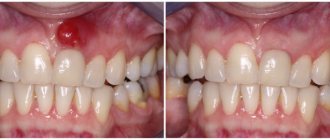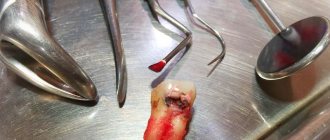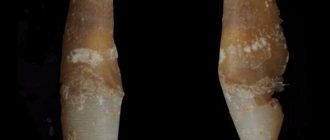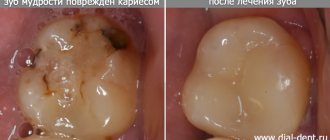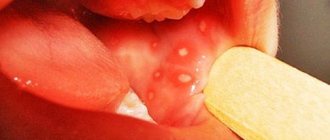The most severe form of acute pulpitis is diffuse pulpitis
, which occurs if focal pulpitis is not treated.
When it occurs, a focus of inflammation is formed, which after about 48 hours affects the pulp in the crown and root parts of the tooth. Acute diffuse pulpitis
is accompanied by severe pain and can cause inflammation to spread to adjacent teeth.
By its nature, it is similar to a number of other diseases, and therefore requires a full differential diagnosis. It must be distinguished from focal pulpitis in acute form, inflammatory processes of the nerve in chronic form during exacerbation, sinusitis and periodontitis. Only by correctly recognizing this disease can you prescribe adequate treatment. Only an experienced professional dentist can cope with this, and timely seeking help plays an important role in preserving the tooth.
Filling made of light-curing material for classes I and V - 2,000 rubles.
Filling made of light-curing material in classes II, III, IV - 3,000 rubles.
Placing a temporary filling - 400 rubles.
Resection of the root apex (frontal group) - 6,500 rubles.
Resection of the root apex (chewing group) - RUB 9,000.
Mechanical and medicinal treatment of canals for periodontitis (1 canal) - 1,100 rubles.
Closing perforations (MTA) - RUB 6,500.
At CELT you can get advice from a dental specialist.
- The cost of a dental consultation is 1,000
- The cost of an orthodontist consultation is 2,000
Make an appointment
Symptoms of acute tooth pulpitis
All types of pulpitis have one common feature: damage to the pulp - connective tissue with a large number of microvessels and nerves. It is the presence of a large number of nerve endings that explains the fact that the disease is almost always accompanied by severe pain. Acute pulpitis is considered a signal that pathogenic bacteria have entered the tooth cavity and caused inflammation. Despite the fact that this form is often the initial stage of pulp damage, it causes a number of very unpleasant sensations in the patient from the very beginning.
List of characteristic features
- Sudden attacks of acute pain (on average 10–20 minutes), worsening at night and usually subsiding during the day.
- Reaction to stimuli (usually hot and cold).
- Painful sensations can be localized both within the tooth and can be felt in the temples, ears, and even in healthy teeth (in the second case, these are symptoms of diffuse pulpitis).
The average duration of acute pulpitis is about two weeks. After this period, the disease usually acquires a chronic stage. Due to the gradual destruction of nerve fibers, the pain becomes aching, less pronounced, but longer lasting. Of course, acute pulpitis does not occur on its own, but is a consequence of bacterial activity.
Prevention of deep caries
In order to prevent complications, it is important to visit the dentist in a timely manner, pay attention to proper oral hygiene, and limit the consumption of sugar-containing foods and drinks. Timely treatment of the disease at the initial stage, as well as moderate caries, can prevent the formation of a deep cavity - such treatment is comparatively simpler and less expensive.
Prevention of deep caries consists of following the following recommendations:
- visits to the dentist once every 6 months, professional cleaning of the oral cavity, examination;
- maintaining hygiene at home - brushing teeth, using dental floss, mouthwash;
- rational nutrition - avoiding deficiency of vitamins and minerals.
Causes of acute pulpitis
- Complications of caries. Neglected or incompletely cured caries leads to the penetration of streptococci into the pulp through the dentin tubules - bacteria that have an acid-forming function and thereby create the foundation for the development of infection.
- Injuries of a mechanical or chemical nature that violate the integrity of the tooth. Without a protective layer of enamel and dentin, the pulp becomes extremely vulnerable to bacteria and the effects of the external environment.
- Gum disease in which infection spreads through open periodontal pockets.
- Unsuccessful dental treatment (infection, damage to tooth tissue, etc.).
Secondary treatment of canals and installation of a permanent filling
After a few days, the patient will need to make a second visit to the dentist to evaluate the results of the treatment. An X-ray is taken again, which allows you to evaluate the success of the measures taken and, if the image shows the cessation of the inflammatory process, then the treatment continues and will consist of secondary treatment of the canals and restoration of the natural tooth crown with a photopolymer filling.
While working with the canals, the dentist will remove previously placed gaskets from them, rinse the cavities with an antiseptic, and then seal them with gutta-percha. After completing these procedures, X-rays are taken again, which is necessary to assess the quality of canal filling. Having completed the restoration of the natural tooth crown, the doctor will advise the patient on proper oral care after treatment of pulpitis.
Compliance with the specialist’s recommendations in full is a guarantee that complications will not arise and the treated tooth will not hurt again. We hope the material helped you find out as much useful information as possible about what pulpitis is and why its treatment should begin in a timely manner. Concluding the article, we will add - do not try to cure pulpitis yourself, using traditional medicine, this may be unsafe for your health. The inflammatory process with pulpitis can only be stopped with well-chosen medications, removal of damaged tissue, and all these measures can be put into practice only in a dental clinic. Regularly visiting the dentist's office and undergoing an examination will be the best preventative measure against pulpitis.
In our dentistry "Uni Dent" in St. Petersburg (St. Petersburg), all conditions have been created to guarantee effective, safe and high-quality treatment of pulpitis. For a consultation or to make an appointment with our specialists, just dial our contact phone number!
Acute diffuse pulpitis
Usually it is the next stage of focal pulpitis (sometimes the peak form of chronic) and appears on the third or fourth day. With diffuse pulpitis, inflammation affects both the coronal and root parts of the pulp. The pain is paroxysmal and long-lasting, with periods of relief being rare. The pain is often radiating and radiates to various parts of the head. The fabric begins to become saturated with exudate.
Some sources also highlight acute fibrous pulpitis, but this is not entirely true. Fibrous pulpitis is a form of chronic; acute fibrous pulpitis is also not a completely correct term. It is a chronic complication of diffuse pulpitis. When gangrenous, extensive tissue necrosis occurs and the tooth often takes on a characteristic gray tint.
Clinical researches
Repeated clinical studies have proven that regular use of preventive toothpaste ASEPTA ACTIVE for a month can reduce bleeding gums by 60%, improve the overall condition of the oral cavity by 44% and reduce inflammation by 33%.
Sources:
- Clinical and laboratory assessment of the influence of domestic therapeutic and prophylactic toothpaste based on plant extracts on the condition of the oral cavity in patients with simple marginal gingivitis. Doctor of Medical Sciences, Professor Elovikova T.M.1, Candidate of Chemical Sciences, Associate Professor Ermishina E.Yu. 2, Doctor of Technical Sciences Associate Professor Belokonova N.A. 2 Department of Therapeutic Dentistry USMU1, Department of General Chemistry USMU2
- The problem of treating inflammatory periodontal diseases in patients suffering from type 2 diabetes mellitus E.A. KHROMOVA* Ph.D., Associate Professor of the Department I.V. KULIK* Ph.D., Associate Professor of the Department N.A. UDALTSOVA**, ***candidate of medical sciences, associate professor of the department; Deputy Chief Physician for Organizational and Methodological Work A.K. IORDANISHVILI****,*****Dr.Med.Sci., Professor, Professor of the Department *Department of General Dentistry, North-Western State Medical University named after. I.I. Mechnikov" of the Ministry of Health of Russia; ** St. Petersburg State Budgetary Healthcare Institution “Dental Clinic No. 29”, Frunzensky District, St. Petersburg; ***Department of Maxillofacial Surgery and Surgical Dentistry of the Federal State Budgetary Educational Institution of Higher Education "St. Petersburg State University" of the Government of Russia ****Department of Orthopedic Dentistry of the Federal State Budgetary Educational Institution of Higher Education "North-Western State Medical University named after. I.I. Mechnikov" of the Ministry of Health of Russia; *****Department of Maxillofacial Surgery and Surgical Dentistry of the Federal State Budgetary Educational Institution of Higher Education "Military Medical Academy named after S.M. Kirov" of the Russian Ministry of Defense;
- Clinical studies of antisensitive toothpaste “Asepta Sensitive” (A.A. Leontyev, O.V. Kalinina, S.B. Ulitovsky) A.A. LEONTIEV, dentist O.V. KALININA, dentist S.B. ULITOVSKY, Doctor of Medical Sciences, Prof. Department of Therapeutic Dentistry, St. Petersburg State Medical University named after. acad. I.P. Pavlova
Diagnosis of acute pulpitis
Diagnosis of acute pulpitis includes several stages. First, the doctor conducts a visual examination of the oral cavity: if the tooth has a carious cavity or is injured, and the patient complains of acute pain, then there is a high probability that we are talking about pulpitis. Acute and chronic pulpitis have quite significant differences, so visual diagnosis alone is impossible.
Each of the forms of acute pulpitis (they will be discussed later) has its own manifestations and characteristics. To identify the type and stage of the disease, specialists resort to x-rays and electroodontic diagnostics (EDD), which determines the reaction of the pulp to electric current. Rheodentography (assessment of the blood supply to the pulp) and a thermal test are also quite often performed. In addition, differential diagnosis of acute pulpitis is necessary in order to make an accurate diagnosis and not confuse pulpitis with other diseases with similar symptoms.
Definition of the concept in dentistry
Deep caries is the last stage of the carious process occurring in the tooth, which is characterized by extensive damage not only to hard tissues, but also to the deep layers of dentin. In general, the concept of “deep caries” reflects the depth of the lesion.
Caries can be:
- primary - a consequence of untreated secondary caries;
- secondary (recurrent) - the occurrence of a carious process under a filling in a previously treated tooth.
Based on the sensation of pain and clinical examination, the disease is divided into 3 forms:
- Acute form. It is determined by the narrow entrance opening of the carious cavity and the wide base (during examination), as well as by descriptions of the patient’s sensations - reaction to food temperature and chemical irritants.
- Chronic form. It is characterized by a wide (funnel-shaped) inlet and a narrow base. The patient feels pain when the “hollow” is clogged with food and during examination with a probe by the dentist.
- Deep cervical caries. It is characterized by the development of demineralization of enamel tissue and the carious process in the cervical area of the tooth (near the gums).
According to the clinical course, caries is also divided into several forms:
- compensated,
- subcompensated,
- decompensated.
Treatment of acute tooth pulpitis
Treatment of caries, pulpitis and acute periodontitis forms the basis of the activities of any dental clinic. It is important for the patient to find a doctor whom he can trust with his health. Below is a table that describes the main types and methods of treating acute dental pulpitis.
Treatment methods for acute pulpitis
✔
Classical technique: tooth depulpation, removal of affected tissue and filling.
✔
Biological method of treating acute forms of pulpitis with partial preservation of the pulp. It is carried out in two visits. The first stage involves preparing the tooth, applying therapeutic and insulating spacers, and installing a temporary filling. At the second appointment, a visual inspection and fixation of the permanent filling is performed. This type of treatment is possible only with minimal inflammation of the pulp and at a young age (up to 26-27 years).
Treatment of acute diffuse pulpitis in the vast majority of cases requires complete removal of the pulp. A biological method with the possibility of preserving part of it is possible in a minimal percentage of cases.
Removal of nerve (pulp)
Before this stage of treatment, the doctor carefully isolates the manipulation area from moisture. It is important to prevent saliva from getting into the canal cavities, because pathogenic microorganisms can also get inside the tooth along with it. Moisture insulation of a tooth can be carried out using different methods, but the most modern and effective method of protection is the installation of a rubber dam - a special lining made of latex material.
Next, the nerve is removed. To do this, the dentist takes a special tool with which he winds and then removes the pulp. The treatment of pulpitis does not end there - the next step in it will be the process of treating the canals, before which the doctor must accurately determine their length and get an idea of the shape. For these purposes, an x-ray is taken, and a specialized tool is used: an apex locator.
Treatment of complicated stages of acute pulpitis
Focal and diffuse pulpitis have their own varieties. The first has serous and purulent forms. Focal acute serous pulpitis often occurs as a complication of caries or during improper treatment of caries. It affects the root part of the pulp, which causes sharp attacks of pain. Diffuse serous acute pulpitis spreads to both the coronal and root parts of the pulp, causing severe swelling, which can develop into phlegmon.
Acute purulent pulpitis (pulp abscess), as the name suggests, is characterized by the accumulation of pus in the pulp chamber, throbbing pain, which can radiate to various parts of the jaw and head (which is why the patient often cannot identify the diseased tooth). For successful treatment, it is necessary to completely remove the pus from the canals, and in most cases the tooth is subsequently killed. Treatment of acute traumatic pulpitis is usually more difficult.
Treatment and primary filling of canals
Treatment will not give a positive result if the tooth canals are poorly processed and sealed. To fill them correctly and to the required level, the doctor will first expand their cavity with special devices - K-files or reamers. Expanding the canals to the required level, the dentist will wash them from time to time with an antiseptic: this is necessary to completely wash out pathogenic microflora from the cavities.
When the specialist prepares all the tooth canals for filling, he will dry their cavities from moisture and place in them pads soaked in medicine that can completely eliminate and stop the inflammatory process. The tooth is then closed with a temporary filling, and the patient goes home.

